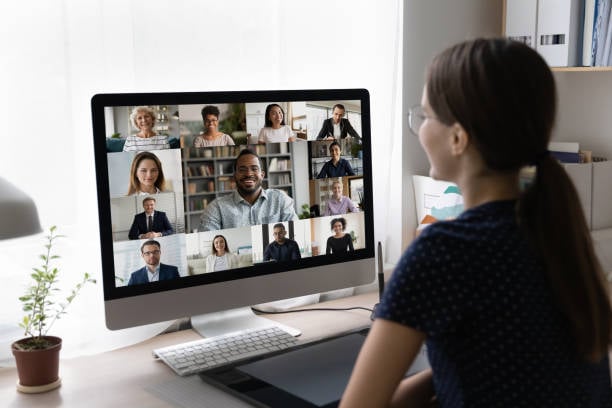December 23, 2022
 by Bente Pieters / December 23, 2022
by Bente Pieters / December 23, 2022

As the employee communications landscape continues to develop, organizations keep exploring the most efficient ways to reach their employees without interrupting their staff's focus.
Since so many of us work on remote or hybrid teams, reaching employees all at once with relevant information takes time and effort. This is where visual communication steps in and employee communication software can be of great help. Companies that use visual communication sparingly are missing opportunities to engage their employees more effectively.
Visual communication conveys information or ideas using visual elements. It can include illustrations, animations, pictures, videos, infographics, diagrams, maps, and even GIFs and memes, depending on the message's goal and target audience.
Thanks to social media platforms such as Instagram, Pinterest, Snapchat, and TikTok, creating, sharing, and consuming visual content has never been easier. Although textual information has its place, to explore specific topics more deeply and expansively, you can't get around visual communication – and why would you want to?
Grabbing your audiences' focus is key in an overstimulated, inattentive, competitive world. Pairing your message with visual elements gets attention and delivers your message quickly and clearly.
Maybe it’s time to consider using the benefits of this communication type for your company’s most important asset: your employees.
Source: netpresenter
The mountains of data and information everyone encounters every day have never been higher. Information overload surrounds almost all aspects of life.
At the same time, today's workforce is transforming to represent a growing number of employees who are used to visual information in their personal lives, and so they expect it at work, too. This changing workforce requires rethinking your methods of communication. Visual employee communication needs to be part of the solution to reach your busy, hybrid workforce.
Undoubtedly, you update your staff daily with all sorts of news. Maybe you send (lengthy) emails, post articles, and documents, or publish an employee newsletter. When you replace or combine textual information exchanges with visual elements to convey your message, you’re putting visual communication to work.
Visual resources are indispensable when you need to attract attention. Carefully choosing and displaying visual elements makes you stand out. Various statistics about human beings verify the superiority of visuals in drawing people's interest. But why do visuals win the competition for your attention when the text doesn't?
Humans process visual content at high speed.
Part of the explanation is scientific. To begin, humans process visual content at a higher speed than the written word. The human brain processes an image in just 13 milliseconds, while it takes several hundred milliseconds to understand printed words. Visual communication informs without asking for too much attention.
Our visual processing is more evolved.
Human brains can handle multiple images in parallel. The text must be scanned one unit at a time. These units are then recognized and assembled into larger units such as words, word groups, and sentences. Only after that can the mind look for meaning.
Knowing this, you can visualize ideas or combine text with visuals to communicate with your team about concepts that are hard to convey with words alone.
So, how else can visual communication benefit your business?
Source: netpresenter
For internal communication, adding visual content to your communication arsenal provides information more effectively. Visual employee communication has benefits across the entire workforce. Your employees’ ability to learn and remember content, complete tasks, and absorb information improves when you communicate visually, but that’s not where the advantages end.
Visual communication goes beyond enhancing comprehension; it also aids in streamlining processes and clarifying complex workflows. Using a process flow diagram, you can visually map out the sequential steps and interactions involved in a particular task or workflow, making it easier for your employees to understand and follow.
Visual communication helps employees complete tasks. According to TechSmith research, 67% of employees are better at finishing their work when a video or an image is added to just plain text. They’ll also perform 7% faster when your communications include graphics. And as if that wasn't enough, using text combined with visuals instead of stand-alone text increases accuracy by 8%; using video instead of text raises accuracy by 6%.
There’s a good chance your staff likes visual communication better. It’s ubiquitous in your staff's private lives, so they’ll crave more visual employee communication. 48% of employees rate video as the most engaging form of communication, and 37% consider text with images the most engaging. Text still plays an important role, but it works better as a supporting role.
Research shows that Gen Z brains are structurally different from those of earlier generations in response to our environment. Gen Z brains have become wired to complex visual imagery, and the part of the brain responsible for visual ability is far more developed, making visual learning more effective.
Source: netpresenter
Visual employee communication starts with researching the available tools and channels, your target audiences, and preferred content types.
Consider which tools and channels suit your team when implementing visual employee communication. Analog communication, like flyers and posters, may come to mind. But don't forget about all the fantastic digital tools available nowadays.
Digital tools are more effective: updating an intranet or digital signage screen is easier than replacing posters across your premises. Changing the slides on a digital signage screen takes seconds. It lets you change the slides of your screens from one content management system, wherever they are. Even in another branch. Even in another country!
You want your visual communication to remain current. You may want it to move, to change, to be dynamic. And if you want to be able to spread information in (near) real-time, digital is the way to go. No surprise that many internal communication (IC) teams prefer digital communication channels.
Some of the great digital tools that are suitable for employee communication include:
Choosing the most effective tools for your organization depends on several factors, like your target audiences and the content you often publish.
Who are the various groups in your organization? Using the right tools for the right audience is key; if you don't know how employees prefer to consume information, you might end up publishing information via channels your staff doesn't use – the exact opposite of what you're aiming for.
Remember the differences between generations of employees; they may all have different preferences for communication channels. If you need this info, a short internal communications survey sheds light on how your team likes to receive information.
Your workforce may include non-desk employees, field workers, and office workers. They can all be reached effectively with visual communication. However, the best communication channel for office workers might need to be more effective for your employees out in the field.
Desk workers, for example, can be reached best via their laptops. Messages on the intranet, a newsletter sent by email, wallpaper, or digital signage for workstations are effective methods for connecting with your office staff.
Digital signage for workstations is the same digital signage you use in your office, but it brings your digital signage into employees' homes. A great solution for hybrid organizations!
Strategically placed digital signage screens or a mobile app is usually the best way to stay in contact with non-office staff. With a mobile app, they’ll always have the right information as close as their phone.
Source: netpresenter
Once you've combined channels and target audiences, determine which types of content convey your messages most appropriately. Consider the content in relation to the channel you’ll use to spread it and the audience that will receive it.
Published at the right time, a CEO blog accompanied by visuals can serve as inspirational content for your target audiences. This type of content works best on an intranet, in a newsletter, or a desktop application because they’re channels people can read whenever they want.
On the other hand, an awareness campaign such as a visual cybersecurity awareness or a health and safety campaign must be repeated continuously. This ensures that the information is always top of mind and that employees know how to act in certain situations.
Present these campaigns in bite-sized chunks to avoid overwhelming staff with too much information at once. Publishing this type of content to channels that continuously repeat messages, such as digital signage screens or interactive screensavers on computers, will add to your staff's continuous training and the message's impact.
For various teams in your organization, visual employee communication conveys all sorts of important messages. This is how your IC team can work with HR, IT, and management to use visual employee communication, cut through the noise, and reach your staff.
Internal communications (IC) teams spread the word across departments and benefit the most from using visuals in their communications. Here are some visual strategies IC teams can use to improve employee communication.
Source: netpresenter
Even the most difficult company announcements can be simplified using visual communication. Infographics, symbols, images, and videos help explain complex procedures, unexpected changes, or new regulations. Keep your sales teams on task by visualizing sales targets, or let everyone know how busy your customer services are by displaying a customer service ticket dashboard.
Visual communication is great for remote work environments because some assignments call for face-to-face interactions. To make communication more personal, you can take videos of people sharing information.
Ask the creator to explain why the information relates to the organization and encourage people to come to them with questions via email or a comment section. Post it to your intranet or an employee app and give staff a break from lengthy emails and documents.
Speaking of lengthy documents, data visualizations are a great way to help employees process large amounts of information and understand the bigger picture. These visualizations can be used in annual reports, team meetings, and presentations, but they can also be displayed on digital signage screens or the intranet.
Visual communication is for the fun stuff, too! Company events like ball games, holiday parties, team building days, and town hall meetings can all be announced using visual employee communication.
Employees are more likely to attend the event when they receive a creative announcement. Don't hesitate to work with the design team for beautifully crafted invites for any of your events.
HR is another area where employee communication can make or break a business. The following visual communication strategies help HR teams communicate with the employees.
Source: netpresenter
Visual communication is a great way to welcome new hires. You can help make them feel like they belong from day one by creating a short piece about who they are and their role within the organization. Add something about their hobbies to help break the ice in conversations with new co-workers.
Publish it on your intranet so people can welcome their new colleagues in the comments. Spread it through digital signage screens across the department floor so everyone knows who the new face is. It will help employees recognize and get to know their new colleagues, and your new hire will feel like people want them to be there.
Managing face-to-face training in today's hybrid work environments is difficult. Creating visual training content helps new hires on their path to success.
Visual content can be used for many purposes, from first-day training to continuous development. It can teach new hires about systems, network security, hierarchy, and contact information for common issues that might come up.
Videos that answer FAQs from new colleagues are a great way to address questions they might already have. Or share your visual PowerPoint presentations with new hires, so they can reread the information you've given them in the first weeks of their new jobs.
Visual training content can be scaled easily. If done right, your content works for one hundred or one thousand employees. And once it's created, you can set it up for new hires so they can learn or be trained, even when you're finishing other tasks. You can train your new hires even when you're not training them!
Many employees love to learn and retain new skills. Want to keep your top talent? Provide learning opportunities. Your organization may already offer online training for your staff. However, visual communication helps create the impact you want to make.
Training sessions are only valuable if employees remember the things they've learned. Visual communication will help the information stick. Using short messages on the intranet to train staff may not be what your employees think of when they think of learning opportunities, but it will surely help them retain information.
Chop up their training into small chunks, pour it into charts, infographics, or presentations, and repeat these through multiple channels. The information will become second nature. Don't want to bother employees with training they don't need? Simply target the individuals who can use the information.
Many organizations mostly – or even only – communicate about employee benefits when new hires start or during annual open-enrollment periods. What a waste of great employee benefits programs! With visual communication, you cut through the noise all year to make your employees aware of what you offer.
In your communication, you should use real-world examples. Instead of communicating that you provide Telemed, show them they have access to a provider they can consult about their toddler's medical issues. Keep your communication short so your staff doesn’t lose interest.
Explain it in simple language, don't use jargon, and make the information scannable. Add color and graphics to clarify or have someone explain benefits with practical examples in a series of short videos. This will help employees remember benefits such as health insurance.
Employee engagement is a complicated topic, but sometimes it’s as simple as remembering someone's birthday, work anniversary, or contract renewal. Visual communication is a great way to celebrate a colleague.
Just pop a message onto the intranet or a Teams channel to give your staff a chance to celebrate their co-worker. Add an image or a celebratory GIF to make employees feel appreciated immediately.
What visual elements can IT use to communicate with different teams in the company? Here's what.
Source: netpresenter
IT teams can answer technical questions faster when they use visual communication. Frequently asked questions or common staff issues can be solved by employees with minimal help or by following a tutorial.
Various types of content apply here: troubleshooting videos, a screencast of a solution, flowcharts, or even full-on instruction manuals.
When company-wide software changes, screenshots, screencasts, and flowcharts guide employees through new protocols. Share a how-to video on specific features with the entire organization to ensure everyone knows how to operate the new software without constantly asking for help.
Make sure these resources are where everyone can find them until your team doesn't need them anymore. A dedicated page on the intranet or an employee app with an output for both desktop and mobile are great places to keep these informational videos and documents.
IT teams can also use visual employee communication to tell their colleagues about scheduled maintenance. Use a featured article on your intranet homepage, accompanied by an eye-catching image, to guarantee employees see your message. You can also use a platform that publishes notifications on top of other applications so your message stands out.
Repeat the date of the scheduled maintenance via multiple channels, such as an employee newsletter, on the intranet, or a corporate Teams channel, so employees see the message multiple times and plan ahead.
Downtime communication should be highly visible, and you should be able to spread it instantly. IT teams could send an email, but what if it’s the email application that isn't working? Desktop alerts, an intranet, a mobile app, or an org-wide Teams or Slack channel are most suitable for times like these.
These highly visual alerts quickly draw attention to important messages and reach employees wherever they are. The same tool can be used to inform employees that their systems are up and running again.
Visual communication is a great way to create a cybersecurity awareness campaign and turn your staff into a human firewall. Split your campaign into chunks of information to teach and train employees how to help avoid cyberattacks and handle certain situations.
Cybersecurity awareness campaigns must be repeated often, so it’s always top of mind. This helps employees think twice before clicking a link or sending their “CEO” confidential information.
Publish your campaign via screencasts on the intranet or an employee mobile app. Use slides with screenshots that are continuously repeated on digital signage screens, lock screens, or recurring messages in your employee newsletter.
Employ visual communication to replace purely informational meetings. If a meeting is purely informational and doesn't require brainstorming or immediate feedback, try switching it up with a video.
Employees can watch it whenever they want to. No interruptions or conversations distract from the main message. The information will still get to the intended audience. As a bonus, your employees will appreciate avoiding another meeting that could have been an email.
With the assistance of IC teams, management can record a quick video and then add text, slides, graphics, or symbols to clarify the information. After that, it’s sent out to anyone who needs to see it.
Something else to contemplate is many employees' curiosity about 'those at the top’. They want to connect a face to the name, but bringing everybody face-to-face with the C-suite in large organizations is impossible.
Visual communication can help with that. There’s often a distance between top management and staff, and video is a great medium to bridge that gap.
Videos are more personal, imaginative, and clearer than written communication. They don't have to be long. A short video is a great way to get people's attention on a busy workday.
It won't take much time to watch, so leaders can connect with employees without taking a large chunk of their day. A minute may sound short, but it's enough time to highlight an issue.
Visual communication can also be of great help during a crisis. If an emergency unfolds, employees will want to be informed by leaders about appropriate actions. Leadership can use visual communication to tell what is happening and what will happen in the future. Visuals help employees understand complex ideas faster and more easily during pressing times.
For example, leaders can use before-and-afters, change maps, or other visuals that show stakeholders how the organization deals with the crisis and how things might look after the crisis.
Instead of overwhelming employees with complicated texts or technical data, images and visual communication contextualize the crisis in an understandable narrative framework.
Source: netpresenter
Every organization should consider how to reach their own workforce best. However, companies in the same industry face similar problems that can be solved with visual employee communications.
Brief and asynchronous visual employee communication and interesting writing effectively reach busy, overworked clinical employees. Use infographics to visualize important procedures or videos to explain things like proper hand washing. Slides with bright colors and intriguing headlines make it easier to explain difficult information to patients and visitors.
To ensure your employees get your message, try out a variety of communication channels. Overhead announcements may not reach certain areas of your healthcare facility, but new instructions must travel fast if there's an update on an important procedure. Publish information in multiple ways digital signage, text alerts, or high-priority messages via collaboration tools.
Combine these messages with an article on the intranet or an email to cover all bases. Keep messages in a desktop app so staff can reread them when they have time to spare.
Reaching employees in industrial organizations requires tools and channels that take the information to wherever staff is working at that time, even if they're in the field. Digital signage and mobile phones are perfectly suited for communicating with non-desk employees.
You can also spread visual safety instructions, share incident reports, or display days without accidents to motivate staff to work safely.
These channels allow you to publish short messages accompanied by clarifying visuals that employees see on the go. Combine them with other channels, such as the intranet, and add a QR code that leads to your messages.
They can go to the full article on your intranet or website from that short message. Everyone in your organization will have the full information.
Visual employee communication works great for desk workers. Visualizing data and information from Power BI, SharePoint, or Excel helps them remember the information and monitor what's important.
A summary on your digital signage screens of the full article on your intranet or in an email perfectly combines visual and textual communication. The first one draws attention and redirects; the second gets the message to the right audience.
Teenagers and young adults have taken the ball and run with it in terms of visual content. Whether it’s TikTok, Instagram, or Snapchat, you’ll certainly catch this hard-to-reach audience's interest with visual communication like tweet-length messages accompanied by eye-catching pictures.
If you want to ensure they get your message, publish a video. Gen Z loves watching short-form videos. They can contain all sorts of messages: information about upcoming events, tutorials on how to save money, promotional videos for prom night, recaps of special days, and advice about college essays. Publishing these messages on students' devices helps you increase your reach.
While a mobile-first approach using an app is a great way to reach students, staff in schools shouldn’t be forgotten. With this mix of audiences, a multichannel communication strategy best reaches everyone. Try connecting with your staff through school portals, the intranet, your school's website, or their smartphones. Students aren't the only ones glued to their smartphones nowadays.
Visual communication aligned with a great communication strategy helps you contact all employees while boosting engagement and supporting educational goals. Employees and students alike will understand, remember, and identify content more easily.
Most companies have only begun exploring visual employee communication's full potential. Once they fully implement it into their communication strategies, they’ll reach their workforce with engaging, inspiring, and motivating correspondence.
It drives employee engagement while increasing information retention and performance speed. And employees prefer visual communication.
The future of communication is visual – so why not start innovating today? Start by investing in your remote teams and learning more about remote work communication.
Bente Pieters is an online content creator at Netpresenter, a pioneer in the field of employee and emergency communication. She and her team help organizations keep employees better informed, engaged, productive, and safe.
Although talk of the Great Resignation and quiet quitting have died down, employee engagement...
 by Abby Guthkelch
by Abby Guthkelch
Internal newsletters are a classic way to inform and engage employees.
 by Barbara Marzari
by Barbara Marzari
Day in and day out, HR managers are inundated with requests.
 by Mara Calvello
by Mara Calvello
Although talk of the Great Resignation and quiet quitting have died down, employee engagement...
 by Abby Guthkelch
by Abby Guthkelch
Internal newsletters are a classic way to inform and engage employees.
 by Barbara Marzari
by Barbara Marzari


